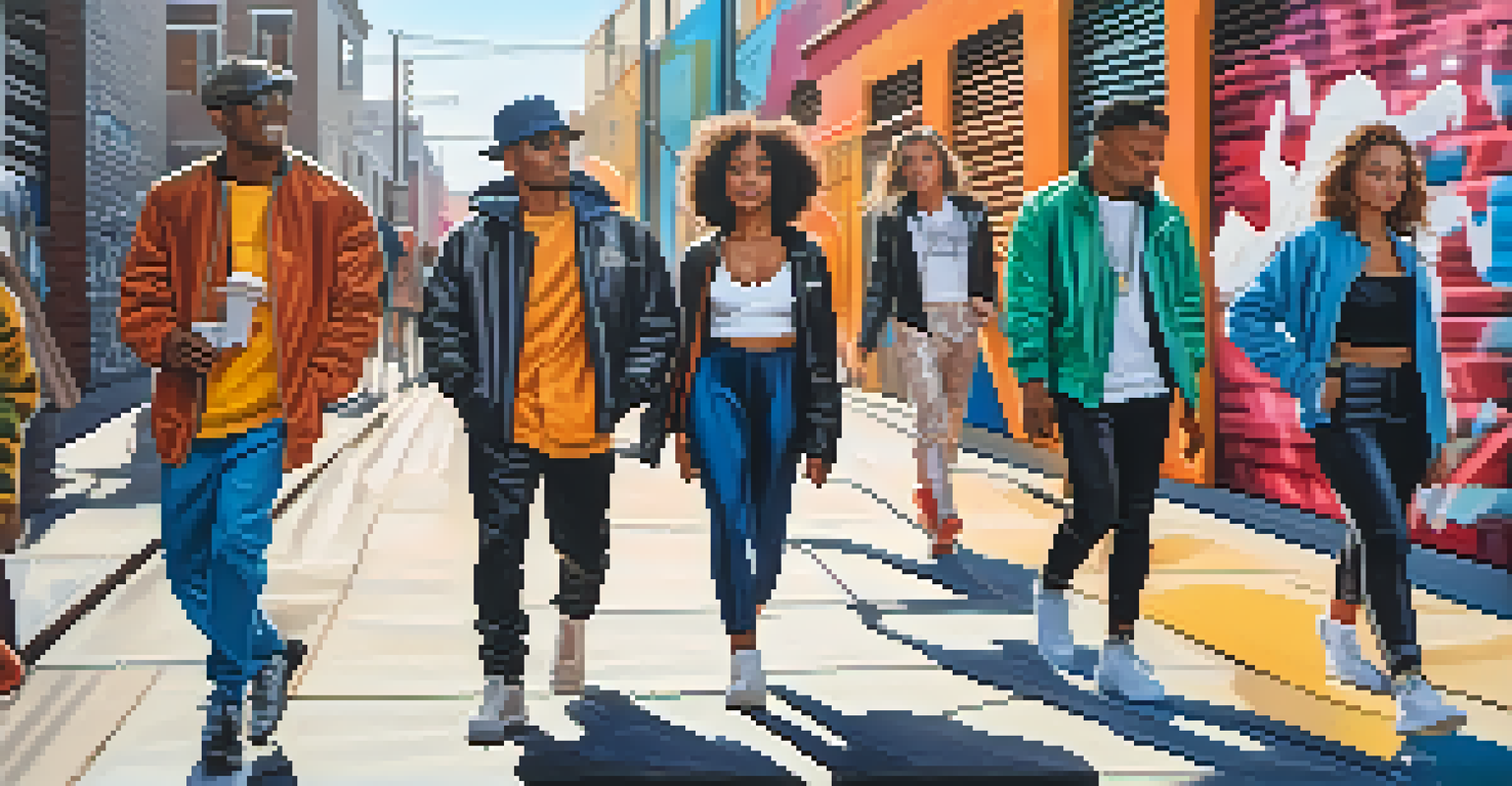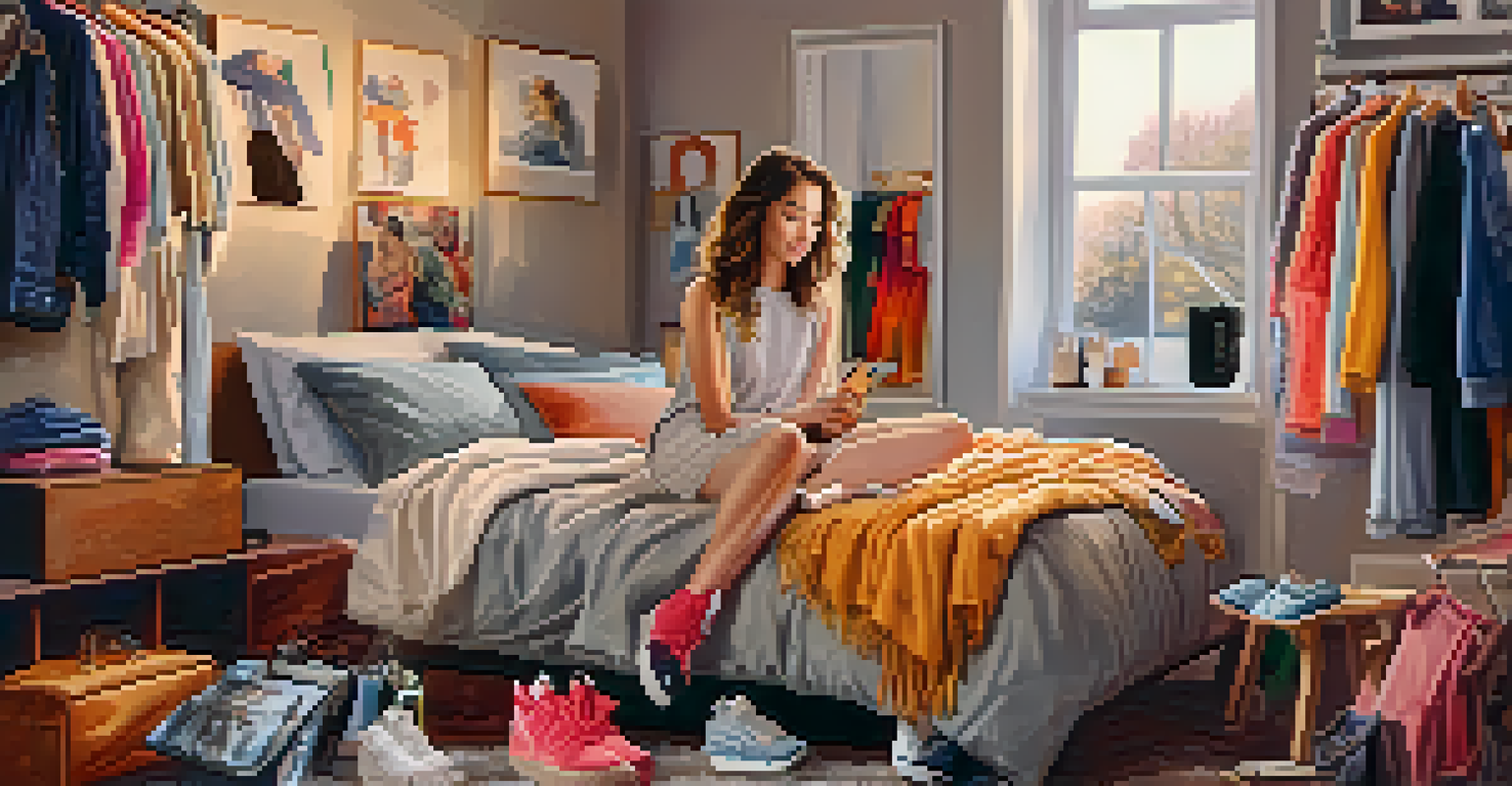The Impact of Social Media on Personalized Fashion Trends

The Rise of Social Media in Fashion
Social media has revolutionized the way we consume fashion. Platforms like Instagram and TikTok have become the go-to places for fashion inspiration, allowing users to see a vast array of styles and trends at their fingertips. This shift from traditional advertising to social media marketing has empowered influencers and everyday users alike to showcase their unique styles.
Fashion is the armor to survive the reality of everyday life.
As people scroll through their feeds, they’re not just passively observing; they’re engaging with content that resonates with them personally. This engagement creates a sense of community, where users share their own interpretations of trends, fostering a more inclusive fashion environment. It’s no longer just about what’s trending, but about how individuals interpret those trends.
Moreover, the immediacy of social media means trends can emerge and fade away in the blink of an eye. This rapid cycle keeps fashion fresh and exciting, but it also challenges consumers to keep up with the pace. Ultimately, social media has become a powerful tool that shapes not just the industry, but also the choices of individual consumers.
Personalization Through Social Media Algorithms
Social media algorithms play a crucial role in personalizing the fashion experience for users. These algorithms analyze user behavior and preferences, curating content that aligns with individual tastes. This means that the more you interact with certain styles or brands, the more tailored your feed becomes, making it easier to discover fashion that speaks to you.

For example, if you frequently engage with sustainable fashion content, your algorithm will begin to show you more eco-friendly brands and influencers. This not only helps users find pieces that resonate with their values but also encourages sustainable choices in fashion. As a result, social media serves as a personalized shopping assistant, guiding users toward their desired styles.
Social Media Transforms Fashion
Platforms like Instagram and TikTok empower users to engage with fashion trends, fostering a more inclusive community.
However, this personalization also raises questions about echo chambers. While it’s great to see what you love, there’s a risk of missing out on diverse perspectives and styles. Balancing personalized content with exposure to a variety of fashion influences can enhance creativity and personal expression.
Influencers and Their Role in Trendsetting
Influencers have become the modern-day fashion icons, significantly impacting what we wear. Their ability to reach large audiences and create authentic connections allows them to dictate trends in ways that traditional celebrities may not. Followers often look to influencers for style inspiration, leading to the rise of specific trends like cottagecore or athleisure.
Style is a way to say who you are without having to speak.
Moreover, influencers often showcase how to style pieces in unique ways, encouraging followers to experiment with their wardrobes. This not only promotes individuality but also inspires users to embrace their personal style rather than conforming to mainstream trends. It's a refreshing shift that celebrates creativity in fashion.
However, the influence of these trendsetters can also lead to a homogenization of style, where many people start to look similar. While this can create a sense of belonging, it’s essential for consumers to remember the importance of personal flair and to use influencers as a source of inspiration rather than a template.
User-Generated Content and Its Impact
User-generated content (UGC) has emerged as a powerful force in the fashion industry. When users share their outfits and styling tips, it not only builds a sense of community but also serves as authentic marketing for brands. UGC often feels more relatable and trustworthy than traditional advertising, making it a valuable asset for brands looking to connect with their audience.
For instance, hashtags like #OOTD (Outfit of the Day) encourage individuals to share their daily looks, creating a platform for diverse fashion expressions. This grassroots movement allows everyday people to become part of the fashion conversation, showcasing that style isn't reserved for the elite but is accessible to all.
Personalized Fashion Experiences
Social media algorithms curate content based on individual preferences, helping users discover styles that resonate with them.
Furthermore, brands are increasingly recognizing the importance of UGC in their marketing strategies. By featuring real customers in their campaigns, they not only foster loyalty but also encourage more users to engage with their products, creating a cycle of inspiration and authenticity.
The Influence of Fashion Challenges and Trends
Fashion challenges on social media, like the '30-day outfit challenge,' have engaged users in fun and creative ways. These challenges encourage individuals to think outside the box and explore their personal style, often leading to new fashion discoveries. The collaborative nature of these trends fosters a sense of camaraderie among participants, as they share their interpretations with one another.
Moreover, these challenges can highlight various fashion subcultures, from vintage to streetwear, showcasing the richness of personal expression. They allow participants to step out of their comfort zones while connecting with others who share similar interests. This shared experience can lead to lasting friendships and a deeper appreciation for diverse fashion aesthetics.
However, while these challenges can be invigorating, they may also pressure individuals to constantly produce content. It’s essential to approach these trends with a mindset of enjoyment rather than obligation, ensuring that personal style remains a joyful expression rather than a chore.
Sustainability Trends Driven by Social Media
As social media amplifies conversations around sustainability, it’s influencing fashion trends towards more eco-conscious choices. With hashtags like #SustainableFashion trending, users are becoming increasingly aware of the environmental impact of their clothing choices. This has prompted brands to rethink their practices and adopt more sustainable methods in their production processes.
Social media platforms offer a space for education on sustainable fashion, with influencers and activists sharing tips on how to shop responsibly. From thrifting to upcycling, these practices not only reduce waste but also encourage creativity in personal style. Users are discovering that sustainable fashion can be both stylish and ethical, reshaping their purchasing habits.
Sustainability Gains Momentum
Social media amplifies awareness of sustainable fashion, encouraging consumers to make eco-conscious choices.
However, it’s important for consumers to remain critical about ‘greenwashing,’ when brands falsely claim to be eco-friendly for marketing purposes. By staying informed and supporting genuinely sustainable brands, individuals can contribute to a more responsible fashion industry.
The Future of Fashion in the Digital Age
Looking ahead, the intersection of social media and fashion is set to evolve even further. With the rise of virtual try-ons and augmented reality, consumers will have more tools at their disposal to personalize their shopping experiences. This technology has the potential to revolutionize how we interact with fashion, allowing users to visualize how pieces will look on them before making a purchase.
Additionally, as social media continues to influence trends, brands may increasingly rely on data analytics to tailor their offerings. By understanding consumer behavior in real-time, they can create collections that resonate with their audience, making fashion more accessible and relevant than ever.

Ultimately, the future promises a more dynamic and inclusive fashion landscape. As social media continues to empower individuals and brands alike, we can expect a continual evolution of styles that reflect personal expression, community, and sustainability.